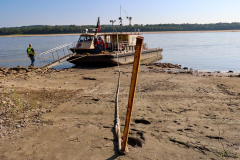ON THE MISSISSIPPI RIVER – In the wheelhouse high atop the rumbling, 240-foot boat, James Garner perched in a chair surrounded by levers, dials and screens. Below him, the Dredge Potter inched up a remote stretch of khaki-colored water between Missouri and Illinois.
Garner was controlling a bus-sized metal vacuum shaped like a kitchen dustpan submerged just in front of the boat. Its water jets agitated the river bottom before pumping the sediment through a floating pipe that snaked downriver – and to shore.
“That’s the color of money,” Garner, 47, remarked as he checked to make sure the brown shade of water and mud spewing on the bank was the right mix to avoid a jam.
Near him sat a pilot, who, along with two tugs on either side, kept the boat dredging the right coordinates as winches pulled in anchors set far upstream. The dredging crew knows any interruption can have outsize economic consequences.
For 92 years, the U.S. Army Corps of Engineers’ Depression-era dredge has helped maintain a 9-foot-deep Mississippi channel for tow barges that haul more than 500 million tons of cargo a year on America’s most important maritime highway.
That work has taken on heightened urgency this year, as drought and heat reduce river levels and rekindle worries about a second year of costly shipping delays.
Last fall, drought led to about 40 days of critically low water in parts of the Mississippi that hadn’t seen it in years – grounding barges, stalling traffic, blocking river ports at the height of harvest season and causing an estimated $20 billion in losses, according to AccuWeather.
As this year’s harvest approaches, the river is again on the decline.
It’s still not known whether the river will drop as low as last year. But Mississippi water levels have been falling since June. The Ohio River – where it meets the Mississippi at Cairo, Illinois, and serves as its largest tributary – dropped almost 10 feet in the last two weeks of August. Levels are predicted to fall farther in the coming weeks.
With 61% of the Midwest classified as abnormally dry or in drought as of late August, most of the Mississippi is expected to face low water in September that will most likely affect industry and navigation, according to the National Integrated Drought Information System.
That is, unless enough rain falls in the right places and amounts.
“Right now, there’s no rainfall in sight that will turn things around,” said David Welch, a National Weather Service hydrologist at the Lower Mississippi River Forecast Center.
That’s worrying farmers who ship grains such as soybeans on the river to New Orleans and, from there, around the globe – relying on lower costs that help keep it competitive for the global export market. They fear another year of backups and spiking costs that eat into profits.
Already barges have had to reduce their loads to float higher in the water. Meantime, 17 dredges work to maintain the navigation channel. In Louisiana, the Corps is building an underwater sill for the second year in a row to keep seawater from pushing upstream and damaging drinking water systems.
Uncertainty about weather and water has always flowed through the livelihoods of those along the Mississippi, who are no strangers to cycles of drought and flood and the wide mix of factors that impact river conditions.
Short-term climate cycles such as El Niño are part of the reason for drier conditions this year. But more heat and extreme weather may translate into wider and more frequent swings on a river that helps carry a nation’s economy.
“Yes, we have that normal water cycle. But we’re seeing an acceleration of how fast water moves through the cycle due to warmer temperatures in general,” said Mark Svoboda, director of the National Drought Mitigation Center at the University of Nebraska-Lincoln.
Up and down the river basin, those who depend on it were watching the forecasts: A towboat captain who has plied the river for decades. An Army Corps officer looking out over the water in Memphis, Tennessee. And farmers just beyond the levees, their grain ripening in the field as both harvest and rising freight costs loomed.
On the Dredge Potter, the challenges could be seen in often-submerged dikes that now protrude from the river nearby – as well as the vast fields of ripening soybeans and corn that sat green in the late-summer sun.
“It’s a really critical period. We need to have our supply chain operating and firing on all cylinders,” said Mike Steenhoek, executive director of the Soy Transportation Council. “The crystal ball is not very encouraging. And what that portends is that we could be in a situation similar to where we were last year.”
How a dwindling river impacts commerce and shipping
Eric Badeaux, whose Louisiana roots are evident in his accent, followed his father into the towboat profession when he was still a teenager.
Now 59, Badeaux has logged decades pushing barges on a river basin that drains 41% of the country. In some years, he transited the 800-mile stretch between St. Paul, Minnesota, and New Orleans up to a dozen times.
He learned to read the water’s ripples and shades to discern shallows on an ever-changing river bottom, one whose lower portion flows free of locks and dams but where river engineering, including levees and dredging, has increased flood risk.
The barges, each nearly 200 feet long, are lashed together – often both end-to-end and side-to-side – to form huge floating shipments. Badeaux has pushed them through both high and low waters, including sharp drops in 1988 and 2012.
But last year, he said, was different.
“Last year was the worst it’s ever been,” Badeaux told USA TODAY late last month while loading rock for concrete onto barges on the Tennessee River near Muscle Shoals, Alabama.
In a normal year, a 10,000-horsepower towboat on portions of the lower Mississippi might push as many as 42 barges at once. During the critically low water last year, that same boat could only push about half that number, with each barge loaded with less weight to limit its draft, said Jennifer Carpenter, president and CEO of the industry group American Waterways Operators.
“We saw lower water levels on the Mississippi River and its tributaries, in some places, than had been seen since 1988,” she said. Others saw the lowest ever recorded.
In some spots, towboats could not reach granary ports. Near Memphis, multiple barges were temporarily grounded on shoals, blocking the river and forcing emergency dredging. In Vicksburg, Mississippi, a river cruise ship couldn’t get to a ramp that normally loads passengers. Smaller loads meant more boats and river congestion.
Nearly 60% of all U.S. grain exports are transported by barge.
“You could just look out at the river and know that something really, really strange was happening,” said Cape Girardeau, Missouri, Mayor Stacy Kinder.
All that meant backups for Badeaux, whose trip carrying cargo between Cairo and Baton Rouge took nearly a month, more than twice as long as normal.
“We would stay and stop somewhere in the middle of nowhere and just wait a week at a time,” he said. “The river was pinned down tight.”
The low water eventually eased. And by late August of this year, he was leading a smaller cargo load down the Tennessee-Tombigbee Waterway to reach the Gulf, a shorter loop that let him remain closer to his ailing mother.
But Badeaux was still thinking about the time he spent last year looking through his wheelhouse windows, pondering how it all fit into historic cycles that have faded into the past, as well as heat that seemed to be increasing everywhere.
It brought to mind lyrics of a Hank Williams Jr. song, he said, one that he said everyone was singing: “The preacher man says it’s the end of time, and the Mississippi River, she’s a-goin’ dry.”
Farmers near the Mississippi face yet another uncertainty
In a metal-sided barn near Cairo, Adam Thomas, 36, had been readying his hulking John Deere combine and thresher.
Just outside were acres of knee-high soybean plants, their emerald green leaves yellowing – signaling it would soon be time to harvest.
Across the road and over an earthen levee, almost within eyesight, was the Mississippi – where he’d take his crop to granaries to be loaded onto fleets of towboats.
Thomas, a father of three who scrapped plans to become a history teacher to join his own father in farming, now grows 2,500 acres. One of his plots is here – atop a former neighborhood, along with a nearby Sears factory that once made prefabricated homes. They were torn down as Cairo fell on hard times and never recovered.
But being close to the river – especially at Cairo, perched at the confluence of the Mississippi and Ohio rivers, whose famous river water gauge is a bellwether for the system – remains valuable and the go-to shipping option for farmers within hundreds of miles.
Barges, less expensive than trains, can each carry 70 semi-trucks worth of grain. Industry officials said it’s a key reason U.S. soybeans are globally competitive.
Last year, stymied barge traffic meant nearby granaries filled up, leaving some farmers scrambling for more expensive or distant storage options. By October, barge prices for moving grain downriver from St. Louis shot up 383%, according to the USDA.
“It’s a pretty big price punch against some of your crops,” Thomas said.
Many areas of the Midwest faced periods of drought this year and low waters have already impacted shipping prices. Thomas also saw instances of short, hard rain that caused their own problems. In mid-July, he said, 6 inches of rain in 18 hours wiped out 300 acres of soybeans.
He’s still not sure it will drive any lasting changes in his operation or harvest or selling strategies.
“You sit here and go OK, is it climate change? What’s going on?” he said. “And then the next two years are fine.”
On the other side of the river in Kentucky, a si





